Many times after diagnosing what we think is a door hardware problem, we only to find that the problem is with the door and/or door frame, not the lock itself. This blog post is meant to provide answers to Frequently Asked Questions (FAQs) related to common problems that owners experience with residential entry doors.
Q1. Turning the deadbolt door lock is hard and will not turn all of the way. I did not have this problem before; is the lock worn out or do I have another issue?
There are many reasons why door locks begin to stick and become hard to operate. This could be related to poor workmanship when the door locks were installed, or related to the house gradually settling over time or wear and tear. Any small changes in the alignment of door jams can cause doors and locks to misalign and can often give us a hard time in diagnosing.
If you have ever installed a door lock, you’ve noticed that the latch or bolt mechanism moves in and out with a fairly close tolerance and it does not move much sideways as it slides in and out. Therefore, it is very critical that the small opening in the metal keeper plate attached to the door jam and the latch match up almost perfectly.
Since the lock worked well before, we will assume that it was installed correctly. In order to determine what is causing the issue, you need to look at the door to see if it is warped or if it does not hang square in the frame. Either of these two issues, or a combination of the two, will have an impact on the door lock’s operation. Therefore, you may need to make simple adjustments to ensure your entry door is still aligned and plumb in the doorway and can easily open and shut.
Look carefully around the strike plates and bolt and see if there is a misalignment. If the bolt is out of alignment, the frame may have to be adjusted by installing longer screws in the hinges or putting in additional finish nails to reset or reposition the jam.
Q2. Lately my front door is hard to open and close. It looks like the wood in the door frame has expanded and is rubbing against the door.
Entry doors have to withstand outdoor elements of rain, wind and changing temperatures, as well as the wear and tear of everyday life. The seasonal changes could cause wooden doors to expand and contract, resulting in a warped or swelling door, and any small changes in the alignment of door jams can cause doors to stick. Other factors, such as loose hinges, can make it difficult to open or close a door. The hinge screws may need tightening, otherwise check the door jam; make sure it is flush with the door frame. It could also be water damage to the wood, which would make the wood expand.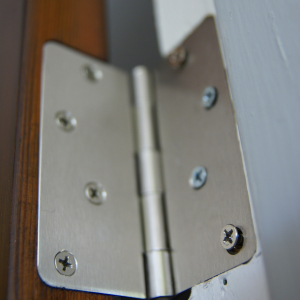
You may need to adjust the size of the door to fit the entryway. Also try tightening and cleaning the hinges and removing any buildup of dirt along the door edges, then see if adjusting the hinges will alleviate the problem. If the door continues to rub, try sanding the edges of the door. If these suggestions do not remedy your door swelling problems consider bringing in a professional carpenter to assist you.
Q3. The front door does not lock properly. The deadbolt works, but the latch doesn’t seem to catch all the time. The home is fairly new; is there a way to fix this?
This is a problem that is typical to new homes. It happens because the foundation is settling and the wood framing is drying out. The changes in the door frame may be causing the door latch to hit the strike plate rather than entering the hole in the plate, preventing the lock from working properly.
If you carefully look at the door from the hinge side when it is almost closed, you can see how the latch aligns with the strike plate. It may be above or below the centerline of the strike plate depending on how your house has settled.
For this type of problem, and depending on the severity of the misalignment, there are two possibly ways to repair the issue. Inspect the strike plate on the edge of the door frame, a latch bolt that sticks in the strike often leaves marks or scrapes on the strike plate. Small changes can be made by removing the strike plate and then filing the metal to enlarge the opening enough to allow the latch to engage. Use any marks or scrapes on the plate as a guide to help you determine which edges of the strike plate may need to be adjusted. Open and close the door to test your work. Continue to file the latch opening a bit at a time until it successfully engages the latch without sticking.
If this repair does not work, then you will have to relocate the strike plate on the door frame either higher or lower. This will require some wood filling and painting to restore the frame to its original condition.
Q4. My solid wood entry door has started to rub on the bottom edge of the door frame, making it hard to open and close the door. Is there anything that can be done to fix this?
Door frames provide the needed support for a door; some solid wood entry doors can weigh more than 100 pounds, swinging open and closed on three narrow metal hinges. The problem may be related to the weight of the door, which takes a toll on hinges and on the frame itself (which may have been designed for a door half the weight). Eventually, something has to give and it’s usually the wood of the door jam. As a result, the door will tend to sag from the top, causing the top of the latch-edge of the door and/or the bottom of the latch side to rub. Other factors, such as thick carpet or flooring, can make it difficult to open or close a door.
The first step is to make a visual inspection of the door when it is in the closed position and look at the hinge side of the door. If there is a greater gap between the door and the frame at the top than at the bottom, the hinge, frame or both have begun to distort from the door’s weight.
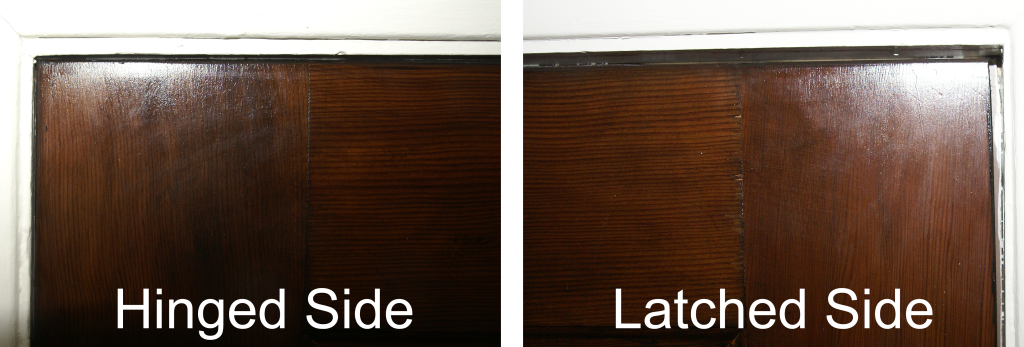
A typical repair recommended for sagging doors is to remove one of the screws closest to the center of the door jam and replace it with the same size screw but longer to extend through the door jam and into the door frame, then tighten the screw in until the hinge begins to pull slightly back toward the frame and stop. If you over-tighten the screw, you might cause the top of the door to rub. Now test the door, you should see that it now clears the latch-side frame with no rubbing.
Q5. Why are my door handle and deadbolt hard to open with the key after it rains?
Entry doors are exposed to outdoor elements of rain, wind and changing temperatures. The seasonal changes could cause the wooden doors to expand and contract, resulting in a warped or swelling door. Even small changes in the alignment of door jams can cause the bolt to rub against the door jam, making it harder to open.
Whenever finished wood rubs up against something, it tends to leave a mark. These marks will typically indicate where the problem areas are and help you fix the problem.
As a simple fix suggestion, first check for hardware failures such as loose screws and hinges. Tighten any loose screws and check the door for sticking. If the problem still persists, you can do some light sanding on the swollen wood door, a little at a time, keeping the door as square as possible. You may have to reapply paint and polyurethane, especially to the edges and replace or install weather stripping as necessary to prevent swelling again.
Q6. My door won’t stay latched and needs to be pushed hard to get it to latch; do I need to replace the door deadbolt lock?
For this type of problem, if the door won’t stay latched or you need to push it hard to get it to latch into the strike plate, the first thing you need to do is to inspect the strike plate on the edge of the door frame. A latch bolt that sticks in the strike often leaves marks or scrapes on the strike plate. Small changes in alignment can be corrected by removing the strike plate and then filing the metal to enlarge the opening enough to allow the latch to engage. Use any marks or scrapes on the plate as a guide to help you determine which edges of the strike plate may need to be adjusted.
Open and close the door to test your work. Continue to file the latch opening a bit at a time until it successfully engages the latch without sticking. If a larger adjustment is needed, unscrew and remove the strike plate, then reposition it on the jamb and reinstall it. You may need to chisel the jamb slightly to install the plate in the new position.

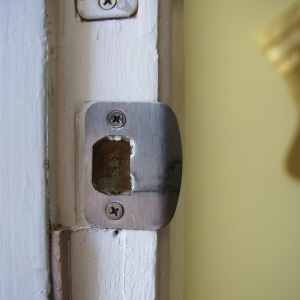
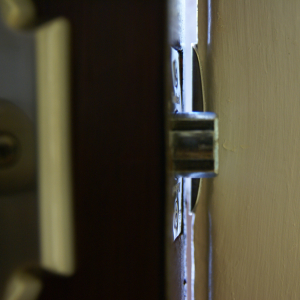
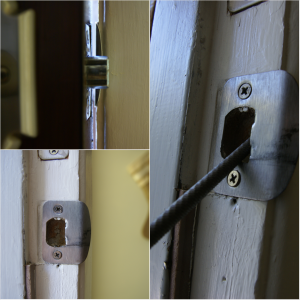










Great tips! The photos are especially helpful!! Thank you!!
Can the quality of the door lock strike plate and latch cause a door to stick.
More background, exterior door so has light preasure from door seal. People grab handle and think door is lock. I have moved the strike plate some. I never had a problem with the door. Just the boss lady.
Poorly installed doors will inevitably shift and get stuck over time. If you are going to replace your doors, buy a quality door and make sure you hire a reputable installation company.
I have been having this problem the past two weeks with a rod iron security door. open and closed fine until two weeks ago when it wouldn’t lock. the lock works fine, but doesn’t catch when closed.
My latch on the inside won’t stay in open position ?
My exterior door won’t lock when I close the door. It doesn’t latch. Any ideas?
We just installed a deadbolt lock. The deadbolt will extent out fully when using the key but only a short distance when you turn the the deadbolt handle. It only seems to move 45 degrees as opposed to 90 when using the key. What are we doing wrong? Thank you.
I cant take the key out without unlocking my new smart key double deadbolt. My front door deadbolt wont lock whatsoever, after taking it in to have a broken key removed. I wonder if I am placing the plate wrong?
Hi Doreen,
We’re going to open a case for you with our support team to help you troubleshoot your deadbolt. They’ll follow up with you directly via email.
Thanks,
Kwikset
Hi T Fontaine,
We’d like to help and will have our consumer service team follow up with you as soon as possible via email.
Thank you,
Kwikset
The dead bolt (Kwickset) was working fine for hundreds of times, then for some unknown reason it would only retract a short way and then it sounded and felt like it was hitting metal, it wasn’t binding on anything, it was smacking METAL in the mechanism, if you could turn the key for all it’s worth you would break the key, I took the locking cylinder out, fiddled and probed with that but could not get the bolt to come all the way back, as best as I can tell the bolt would only come out of the door jam 3/8″ or maybe 1/2″ or so and then it would feel like it hit a Metal Stop. Please don’t tell me to wiggle and jiggle the door or pump it full of lubricant as that’s not the problem. Several of us have probed around the deadbolt mechanism and can’t seem to find anything loose.
I got such a good information on this topic it’s a very interesting one. You made a good site and I have found a similar website please check this one electronic door entry visit the site to know more about Safelocks.
You have discussed an interesting topic that everybody should know. Very well explained with examples. I have found a similar website Maglock Glass Door visit the site to know more about Access Controls Melbourne.
Thanks for sharing an information to us. If someone want to know about Chrome Door Knobs. I think this is the right information for you!
https://www.doorhardware.co.uk/
I’m having a problem with the door that was just installed on my house. It’s a trailer from the eighties. The door does not latch properly. I have to pull very hard on it to get the latch to engage into the whole. It is not possible to move the latch plate as there is no latch plate only a hole for a recess. It seems that the latch and the whole do not lineup properly even of the door frame and the door are one unit. Are there any suggestions to fix this as I’m afraid to leave my house as the door pops open easily.